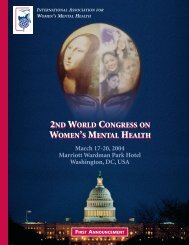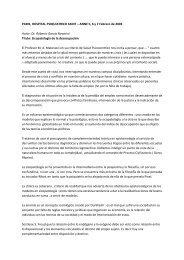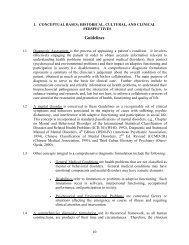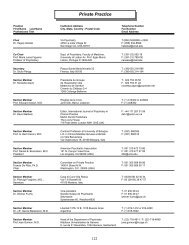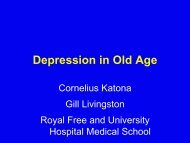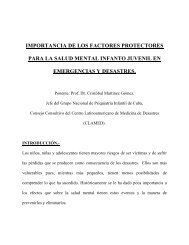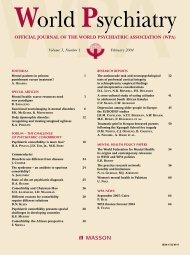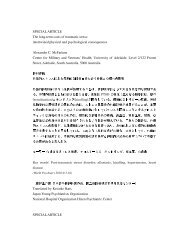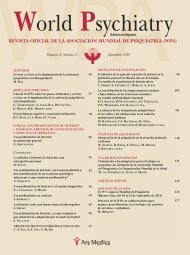ABSTRACTS - World Psychiatric Association
ABSTRACTS - World Psychiatric Association
ABSTRACTS - World Psychiatric Association
You also want an ePaper? Increase the reach of your titles
YUMPU automatically turns print PDFs into web optimized ePapers that Google loves.
attainment and abstinence contingent housing and work/training; contingency<br />
managed work place for abstinent contingent access to paid<br />
work; and behavioral day treatment. Recent ineffective efforts to develop<br />
effective cocaine blocking medication, and research on the treatment<br />
success of disulfiram, with alcoholic and non-alcoholic cocaine<br />
dependent patients, are also to be considered. Current work pointing<br />
the way to likely future clinical developments is reviewed. Bachelors<br />
and masters degree trained counselors, supervised by doctoral clinicians,<br />
are being used to implement manualized effective interventions<br />
with quality control to reduce costs. Dismantling research is discovering<br />
effective component(s) of current effective treatments which can be<br />
used as briefer, less expensive, but still effective intervention. Work is<br />
underway to develop stepped care approaches, which utilize derived<br />
components from effective treatment as initial less complicated and<br />
expensive intervention, where patients who fail to respond can be<br />
transferred to the full intervention from which components were<br />
derived. Lastly, recent work on medication is reviewed, including<br />
efforts to develop blocking medications, a cocaine vaccine, use of old<br />
drugs with new applications, like disulfiram, and use of effective psychological<br />
interventions as a floor treatment for pharmacotherapy.<br />
NRS8.<br />
ETHICAL AND LEGAL ISSUES<br />
NRS8.1.<br />
THE ROLE OF PERCEIVED NORMS<br />
IN THE STIGMATIZATION OF MENTAL ILLNESS<br />
R. Norman, R. Sorrentino, D. Windell, Y. Ye, A. Szeto,<br />
R. Manchanda<br />
University of Western Ontario and Prevention and Early<br />
Intervention Program for Psychoses, London, Ontario, Canada<br />
Although the concept of stigma emphasizes the role of perceived<br />
social consensus or norms in determining reaction to those with a<br />
stigmatizing identity, the importance of such perceived norms has not<br />
been extensively investigated in the context of the stigmatization of<br />
mental illness. Instead, research on the stigma of mental illness has<br />
almost exclusively focused on the importance of an individual’s<br />
beliefs about mental illness and the mentally ill as determinants of<br />
social distance. We present evidence from three studies testing the<br />
hypothesis that individual differences in perceptions of both descriptive<br />
and injunctive norms add significantly to the prediction of behavioral<br />
intention, beyond the level possible using measures of beliefs<br />
about mental illness. Two of the studies involved university students<br />
and one used data from community services clubs. In each case, perceptions<br />
of relevant norms added significantly to the prediction of<br />
preferred level of social distance to a hypothetical individual with<br />
either depression or schizophrenia.<br />
NRS8.2.<br />
THE SIGNIFICANCE OF THE NEW UN CONVENTION<br />
ON THE RIGHTS OF PERSONS WITH DISABILITIES<br />
FOR THE PRACTICE OF INSTITUTIONAL<br />
PSYCHIATRY<br />
M. Perlin<br />
New York Law School, New York, NY, USA<br />
As of May 2008, the UN Convention on the Rights of Persons with<br />
Disabilities becomes international law. The Convention, for the first<br />
time, applies international human rights protections to persons with<br />
disabilities, including people with psychosocial disabilities who are<br />
institutionalized. Among the specified rights are: respect for inherent<br />
dignity; non-discrimination; freedom from torture or cruel, inhuman<br />
or degrading treatment or punishment; freedom from exploitation,<br />
violence and abuse; and a right to protection of the integrity of the<br />
person. It is still highly unclear how these rights will be interpreted by<br />
regional human rights courts and commissions, but it is clear that the<br />
articulation of these rights will bring new focus on institutional psychiatry<br />
worldwide. This paper will discuss the implications of this<br />
new Convention and its meaning for psychiatrists who work in institutional<br />
settings. Among the questions to be raised are the following.<br />
Will the articles of this Convention be interpreted broadly or narrowly<br />
Will the interpreting courts rely on the already-existing bodies of<br />
caselaw based variously on the UN Mental Illness Principles of 1991,<br />
the European Convention on Human Rights and/or American constitutional<br />
caselaw in deciding such cases How will legal representation<br />
be provided in such cases What will (or what should) the role of<br />
organized psychiatry be (if any) in such cases<br />
NRS8.3.<br />
THE WILL TO LIVE AS AN INDICATOR OF WELL-<br />
BEING AND PREDICTOR OF SURVIVAL IN OLD AGE<br />
S. Carmel<br />
Center for Multidisciplinary Research in Aging, Faculty of Health<br />
Sciences, Ben-Gurion University of the Negev, Beer-Sheva, Israel<br />
Conceptually, the will to live (WTL) is defined as the psychological<br />
expression of a natural instinct of human beings, the striving for life,<br />
which is comprised of rational and irrational components, and can be<br />
self-assessed. Considering that the WTL not only expresses a state of<br />
general well-being, but also one’s commitment to life and desire to<br />
continue living, we hypothesized that it is a unique indicator of elderly<br />
persons’ well-being and survival. These hypotheses were put to<br />
test in four large scale national studies of Israelis, one of which used<br />
a longitudinal design. The findings from these studies systematically<br />
show that the will to live significantly correlates with well established<br />
indicators of well-being. It weakens with age, being weakest among<br />
the oldest-old. Furthermore, relatively weak social groups in the population,<br />
such as women and new immigrants, report a weaker WTL in<br />
comparison to their counterparts. The WTL was also found as a good<br />
predictor of long-term survival (7.5 years), especially among elderly<br />
women after controlling for age, health and psychosocial variables.<br />
Based on the systematically repeated findings, we conclude that the<br />
will to live is an important indicator of general well-being, due to its<br />
diagnostic and prognostic values, and recommend using it in daily<br />
practice.<br />
NRS8.4.<br />
MENTAL HEALTH AND DOMESTIC VIOLENCE<br />
FATALITIES: RECOMMENDATIONS FROM REVIEW<br />
BOARDS<br />
J. Wilson<br />
University of Oklahoma, Oklahoma City, OK, USA<br />
Multidisciplinary domestic violence fatality review boards are part of<br />
a growing global movement to prevent family fatalities by analyzing<br />
deaths that occur among family and intimate partners. Multidisciplinary<br />
teams at local, state, and national levels gather aggregate data on<br />
all domestic violence fatality cases and select a number of cases to<br />
review in-depth. Case data is gathered by staff from a broad array of<br />
confidential and public records. Records and chronologies of events<br />
leading up to the fatality are reviewed by board members to answer<br />
the following questions: How could this death have been prevented<br />
143



